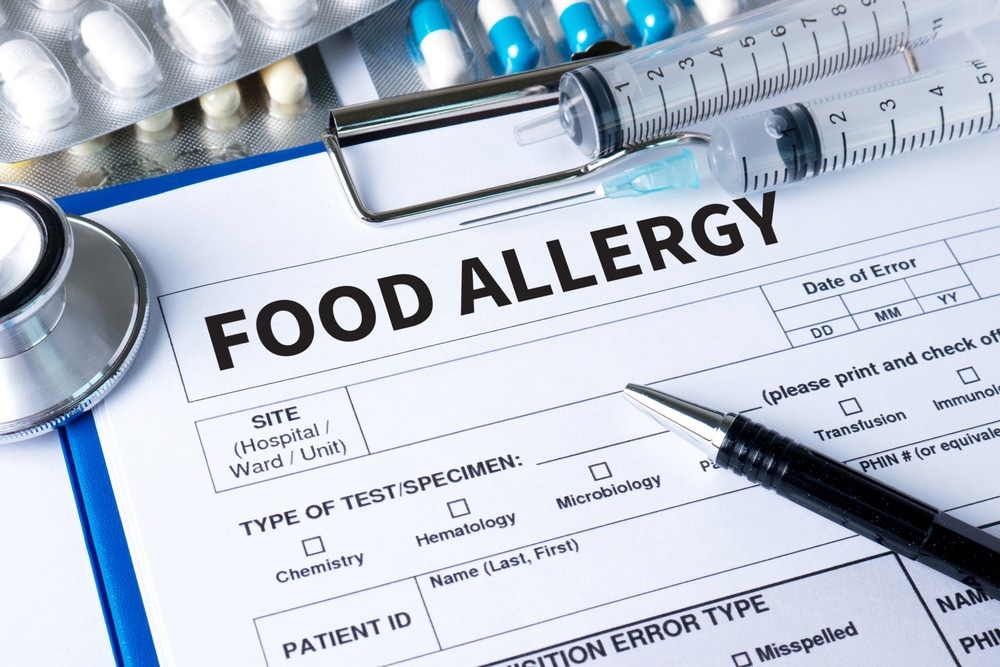Introduction to modern food allergy management
Emerging technologies in allergy detection
Breakthroughs in allergy treatments
Digital health solutions for allergy management
Challenges and considerations
References
Further reading
Food allergies, triggered by specific allergens, can lead to severe reactions like anaphylaxis. However, innovative treatments such as immunotherapy are revolutionizing allergy management. Accurate testing is crucial in identifying food sensitivities, enabling tailored treatment plans for individuals to safely navigate their dietary needs and improve their quality of life.
 Allergy food concept. Allergy food as almonds, milk, pistachios, tomato, lemon, kiwi, trout, strawberry, bread, sesame seeds, eggs, peanuts and bean on wooden table. Image Credit: Evan Lorne/Shutterstock.com
Allergy food concept. Allergy food as almonds, milk, pistachios, tomato, lemon, kiwi, trout, strawberry, bread, sesame seeds, eggs, peanuts and bean on wooden table. Image Credit: Evan Lorne/Shutterstock.com
Introduction to modern food allergy management
Food allergies, an immune system reaction causing distressing symptoms, affect 220 million people worldwide, with a robust trend of escalation observed. This number only represents diagnosed cases, and the actual number of people affected may be higher.¹
This condition ranges from mild discomfort to deadly anaphylaxis and poses an immense challenge to public health. Over 170 foods have been reported to cause allergic reactions; the most common are staples like peanuts, milk, eggs, and seafood.²
These allergies arise from the IgE-mediated immune system's sensitivity to prevalent food allergens. Usually, immune system imprinting by a pathogen or vaccine yields protective memory cells. Still, in some cases, this process can go wrong and produce pathogenic memory cells that react to otherwise harmless ingested substances, leading to the onset of food allergies.³
However, food allergy treatment has undergone significant transformation in the past decades. Initial strategies were limited to avoidance and emergency management, but advancements saw the introduction of oral, sublingual, and epicutaneous immunotherapies. Now, cutting-edge biotechs are propelling personalized medicine, paving the way for groundbreaking treatments using gene therapy and monoclonal antibodies.
Emerging technologies in allergy detection
Routine diagnostic tests for food allergy include oral food challenges, skin-prick tests, and allergen-specific IgE detection. Nevertheless, there are other promising tests in development, such as the basophil activation test, mast cell activation test, and bead-based epitope assay, all focused on specificity and multiplexing capabilities.⁴,⁵
Allergenis is one of the companies involved in the development of these diagnostic tests.⁶ On the other hand, Allergy Amulet has developed an ultra-portable device allowing users to test food for allergens on the go.⁷
Experimental approaches aren't the only ones making great advancements in allergy research. Artificial Intelligence (AI) and Machine Learning (ML) are revolutionizing this field by aiding in the understanding of disease mechanisms, improvement of diagnostic tools, making accurate predictions of treatments/outcomes, and drug discovery.⁸
AI has been utilized to predict the development and persistence of food allergies in pediatric patients. A Deep Learning (DL) framework, employing long short-term memory, was proposed to forecast milk, egg, and peanut allergies in infants from birth to 3 years old using gut microbiome and food allergen-specific serum IgE profiles from the DIABIMMUNE dataset. The DL tool's performance showed promise in predicting clinical food allergy status.⁸
Additionally, AI was used to predict tolerance of oral food challenge (OFC) and response to oral immunotherapy (OIT), demonstrating the potential for early identification of outcomes in patients with food allergies.⁸
Breakthroughs in allergy treatments
The latest developments in food allergy immunotherapy are promising, with innovative approaches like chimeric antigen receptor (CAR) cell therapy aiming to induce true immunologic tolerance.³ Gene immunotherapy using single-dose adeno-associated virus (AAV) vectors shows potential in reducing allergen-specific antibodies and basophil activation, as well as suppressing Th2 responses, which are crucial for allergic reactions.⁹
CRISPR technology also offers groundbreaking methods to edit allergen genes, potentially preventing allergy onset and improving disease management.¹⁰

Image Credit: one photo/Shutterstock.com
Additionally, Omalizumab (Xolair), an off-label monoclonal antibody, is enhancing oral immunotherapy (OIT) by reducing anaphylaxis risks, with ongoing research into its potential to improve OIT's safety and efficacy.¹¹,¹² Meanwhile, Palforzia, the first FDA-approved immunotherapy for peanut allergies, aims to lessen allergic reactions from accidental peanut exposure.¹³
Other innovative strategies are being explored, including recombinant allergens, fusion proteins, alternative delivery routes, cutting-edge adjuvants, and sophisticated formulations like nanoparticles and liposomes, all promising to revolutionize allergy treatment by boosting efficacy, safety, and patient convenience.¹⁴,¹⁵
Digital health solutions for allergy management
Mobile apps like My Pollen Forecast provide real-time environmental allergen data, while the Spokin app is specific for food allergies management. Apps such as Askallergies help manage dietary restrictions while traveling without any language barrier.
Telemedicine services like AllerVie and LiveHealth expand care access. AllerVie provides medical appointments in any state in the US, while LiveHealth allows for remote consultations and follow-ups. These technologies facilitate timely medical advice and personalized care, making allergy management more proactive and patient-centered.
Challenges and considerations
Access to new treatments and technologies for food allergies is rapidly evolving, offering hope for safer and more effective management options. Biologics like Omalizumab have shown promise in reducing anaphylactic reactions during oral immunotherapy, potentially transforming treatment protocols.¹¹,¹²
The FDA-approved Palforzia paves the way for standardized immunotherapies, addressing peanut allergies with a controlled, escalating exposure approach.¹³ However, the balance between efficacy and safety remains a critical consideration.
Each emerging therapy undergoes rigorous clinical trials to ensure that the benefits outweigh the risks. Innovations such as epicutaneous immunotherapy patches, which deliver allergens through the skin, are being evaluated for their ability to provide desensitization with minimal adverse effects.¹⁶ As these new therapies advance, multidisciplinary collaboration is essential to refine treatment regimens, optimize dosing, and establish long-term safety profiles. The ultimate goal is to achieve an equilibrium where the risk of severe allergic reactions is significantly reduced without compromising patient safety.
Conclusion
The landscape of food allergy management is undergoing a significant transformation driven by technological and therapeutic innovations. Immunotherapies such as Palforzia and biologics like Omalizumab are at the forefront, offering new hope for mitigating allergic reactions. Diagnostic advancements and digital health solutions are enhancing personalized care, while AI and ML contribute to a deeper understanding and prediction of allergy patterns.
Despite these strides, challenges persist in ensuring the safety and efficacy of new treatments. The future is promising, with a focus on refining these breakthroughs to ensure they are accessible, safe, and effective for those affected by food allergies, ultimately aiming to improve their quality of life.
References
- Food Allergy Statistics. (n.d.). [Online] https://endallergiestogether.com/research/food-allergy-statistics/#:~:text=Over%20the%20past%2025%20years,affecting%20220%20million%20people%20globally.
- Facts and Statistics. (n.d.). FoodAllergy.org. [Online] https://www.foodallergy.org/resources/facts-and-statistics
- Research, C. F. B. E. A. (2022). Novel and Emerging Therapies for Food Allergy. US Food And Drug Administration. [Online] https://www.fda.gov/vaccines-blood-biologics/biologics-research-projects/novel-and-emerging-therapies-food-allergy
- Sindher S. B, et al. (2022). Food allergy, mechanisms, diagnosis and treatment: Innovation through a multi‐targeted approach. Allergy, 77(10), 2937–2948. https://doi.org/10.1111/all.15418
- Castaño N, et al. (2020). Microfluidic methods for precision diagnostics in food allergy. Biomicrofluidics, 14(2). https://doi.org/10.1063/1.5144135
- allergenis provider site. (n.d.). Allergenis Provider Site. [Online] https://www.allergenis.com
- Allergy Amulet. (n.d.). Allergy Amulet. [Online] https://www.allergyamulet.com
- MacMath D, et al. (2023). Artificial Intelligence: Exploring the Future of Innovation in Allergy Immunology. Current Allergy and Asthma Reports, 23(6), 351–362. https://doi.org/10.1007/s11882-023-01084-z
- Gonzalez-Visiedo M, et al. (2022). Single-dose AAV vector gene immunotherapy to treat food allergy. Molecular Therapy - Methods & Clinical Development, 26, 309–322. https://doi.org/10.1016/j.omtm.2022.07.008
- Brackett N. F, et al. (2022). New Frontiers: Precise Editing of Allergen Genes Using CRISPR. Frontiers in Allergy, 2. https://doi.org/10.3389/falgy.2021.821107
- XOLAIR® (omalizumab). (n.d.). Xolair. [Online] https://www.xolair.com
- FDA grants priority review to omalizumab in treatment of food allergy. (2023). [Online] https://www.healio.com/news/allergy-asthma/20231220/fda-grants-priority-review-to-omalizumab-in-treatment-of-food-allergy#:~:text=Omalizumab%20increased%20how%20much%20peanut,reduce%20reactions%20to%20multiple%20foods.
- PALFORZIA [Peanut (Arachis hypogaea) Allergen Powder-dnfp]. (n.d.). [Online] https://www.palforzia.com
- Blanco-Pérez F, et al. (2019). Adjuvant Allergen Fusion Proteins as Novel Tools for the Treatment of Type I Allergies. Archivum Immunologiae Et Therapiae Experimentalis, 67(5), 273–293. https://doi.org/10.1007/s00005-019-00551-8
- Perez‐Witzke D, et al. (2016). CTLA4Fcε, a novel soluble fusion protein that binds B7 molecules and the IgE receptors, and reduces human in vitro soluble CD23 production and lymphocyte proliferation. Immunology, 148(1), 40–55. https://doi.org/10.1111/imm.12586
- Epicutaneous Immunotherapy (EPIT). (n.d.). FoodAllergy.org. [Online] https://www.foodallergy.org/resources/epicutaneous-immunotherapy-epit
Further Reading